Abstract
Questionnaires (750 respondents, 44.4% response rate) examined the long-term health value of endurance exercise training in older age-classed competitors ('Masters Athletes', 551 men and 199 women) over a 7-year period (1985-1992). The majority had initially completed maximal exercise tests. The weekly time devoted to training, competition and exercise-related travel was 10 to 30 h, and the annual expenditure on clothing, equipment and entrance fees was typically in the range Canadian $500-1500. Despite their age (mean(s.d.) 58(10), current range 40-81 years), only 1.4% reported sustaining a non-fatal heart attack and 0.6% had required bypass surgery over the 7-year interval. The majority (90%) were very interested in good health; 76% considered themselves as less vulnerable to viral illnesses than their peers, and 68% regarded their quality of life as much better than that of their sedentary friends. The majority of former smokers had stopped smoking before they began training, but 37% indicated that exercise had helped them in smoking withdrawal. In keeping with their health-conscious attitude, 59% had regular medical check-ups, and 86% obeyed legislation requiring use of a seat-belt when driving. In contrast with many older people, 88% slept well or very well. Slightly over half of the sample (57%) had sustained some injury which had limited their training for one or more weeks over the 7-year study. Although participation in Masters competition appears to carry considerable health benefits, gains may in part reflect an overall healthy lifestyle.
Full text
PDF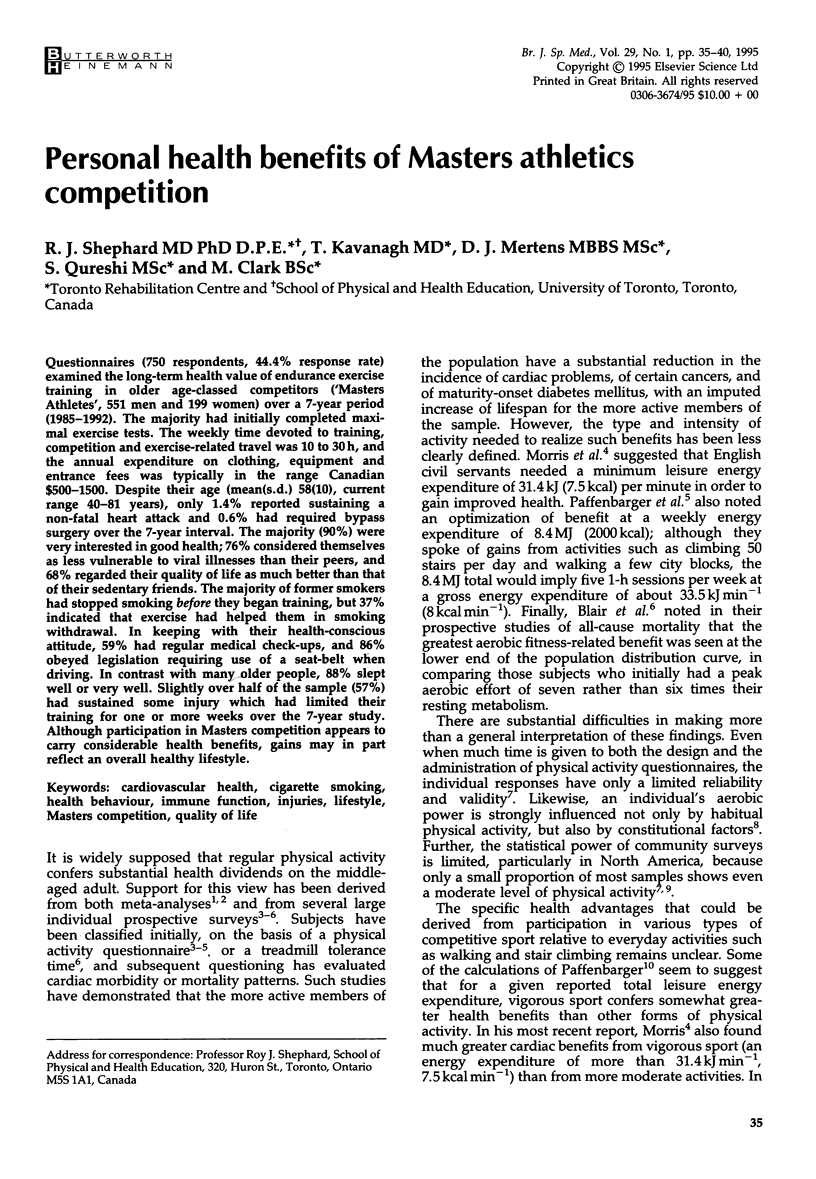
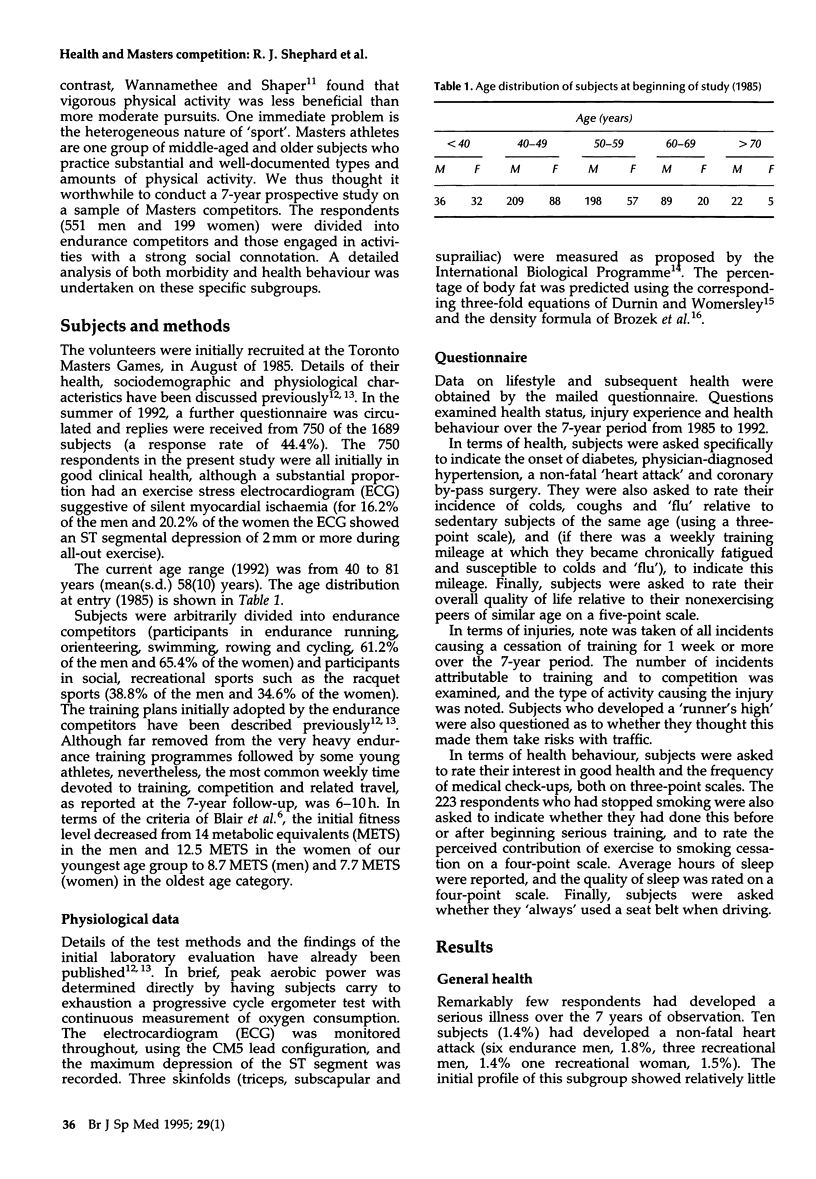
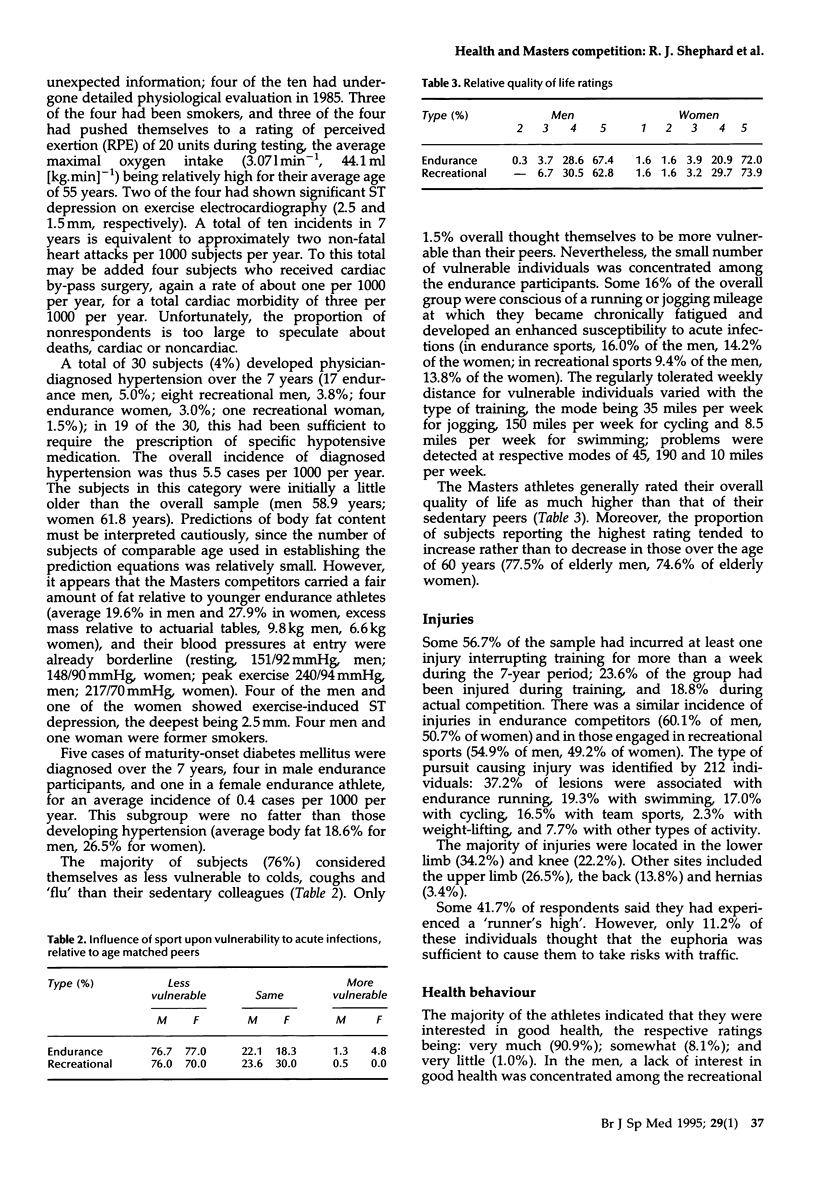
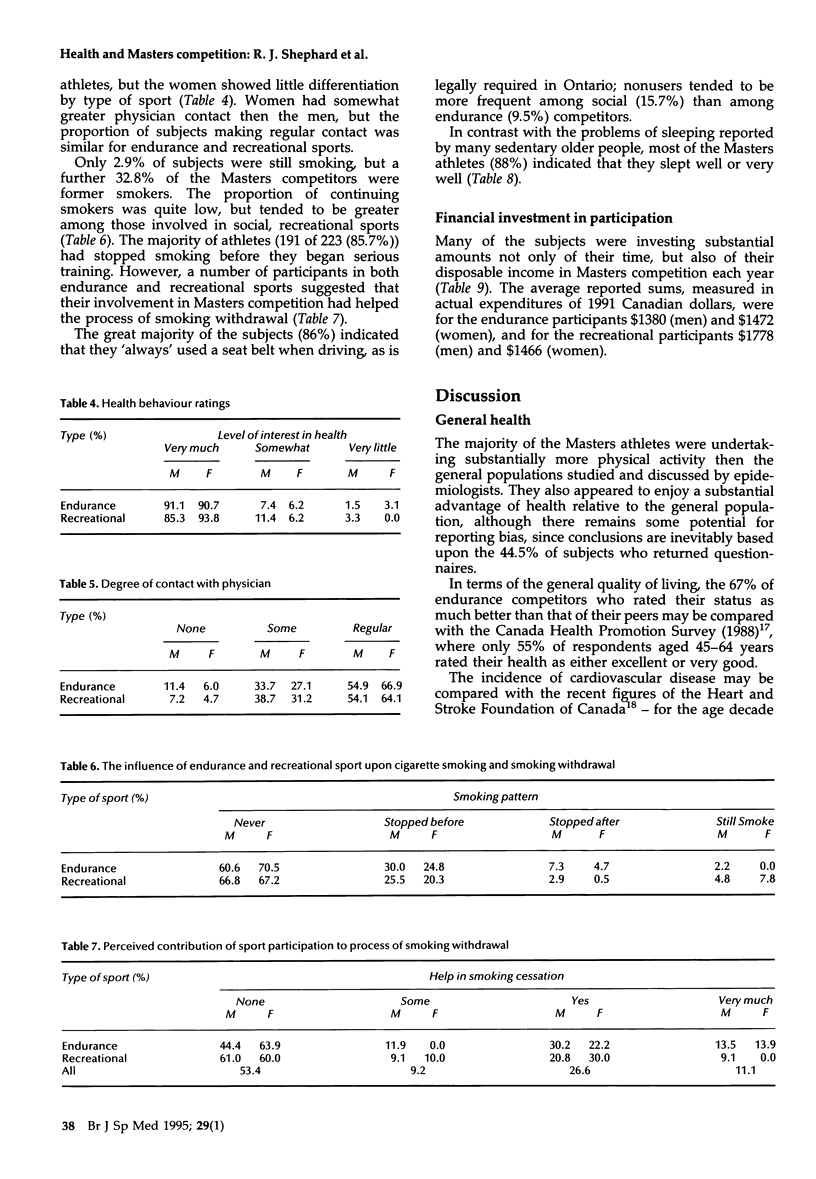
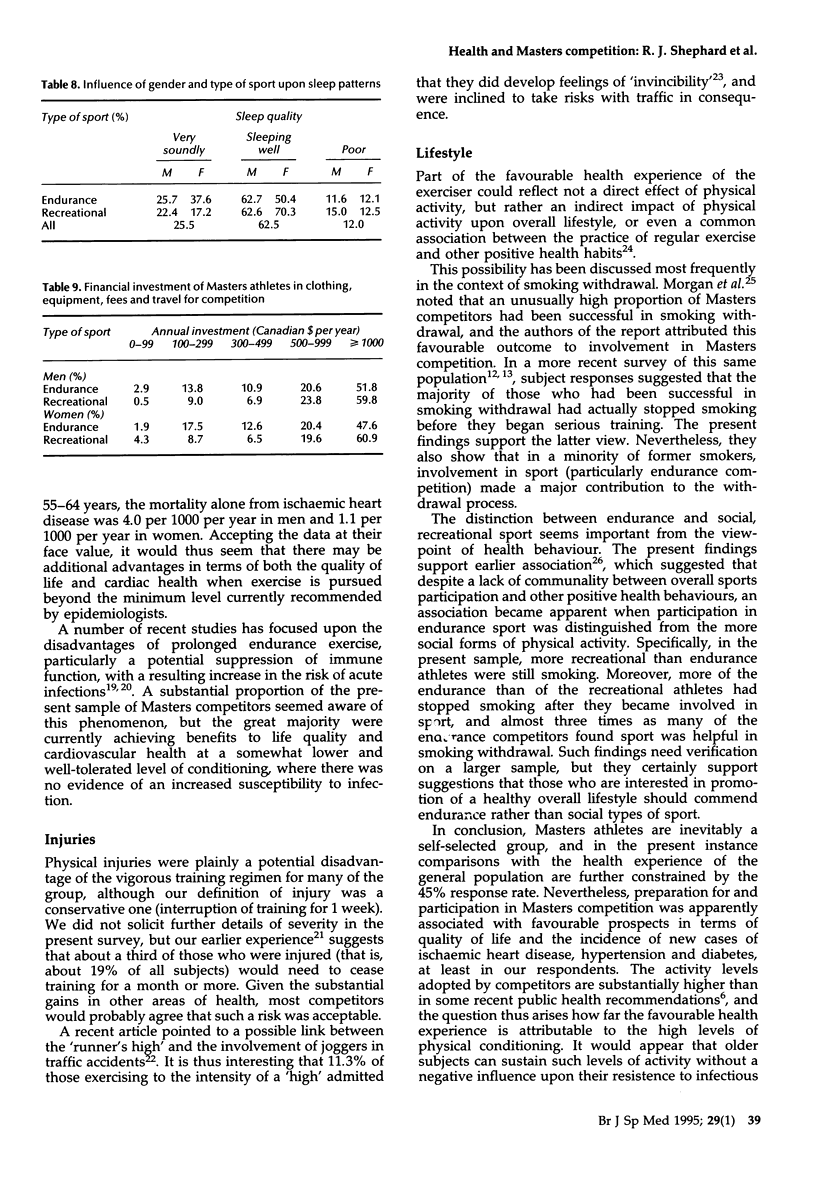

Selected References
These references are in PubMed. This may not be the complete list of references from this article.
- BROZEK J., KIHLBERG J. K., TAYLOR H. L., KEYS A. SKINFOLD DISTRIBUTIONS IN MIDDLE-AGED AMERICAN MEN: A CONTRIBUTION TO NORMS OF LEANNESS-FATNESS. Ann N Y Acad Sci. 1963 Sep 26;110:492–502. doi: 10.1111/j.1749-6632.1963.tb15776.x. [DOI] [PubMed] [Google Scholar]
- Berlin J. A., Colditz G. A. A meta-analysis of physical activity in the prevention of coronary heart disease. Am J Epidemiol. 1990 Oct;132(4):612–628. doi: 10.1093/oxfordjournals.aje.a115704. [DOI] [PubMed] [Google Scholar]
- Blair S. N., Kohl H. W., 3rd, Paffenbarger R. S., Jr, Clark D. G., Cooper K. H., Gibbons L. W. Physical fitness and all-cause mortality. A prospective study of healthy men and women. JAMA. 1989 Nov 3;262(17):2395–2401. doi: 10.1001/jama.262.17.2395. [DOI] [PubMed] [Google Scholar]
- Durnin J. V., Womersley J. Body fat assessed from total body density and its estimation from skinfold thickness: measurements on 481 men and women aged from 16 to 72 years. Br J Nutr. 1974 Jul;32(1):77–97. doi: 10.1079/bjn19740060. [DOI] [PubMed] [Google Scholar]
- Heath G. W., Macera C. A., Nieman D. C. Exercise and upper respiratory tract infections. Is there a relationship? Sports Med. 1992 Dec;14(6):353–365. doi: 10.2165/00007256-199214060-00003. [DOI] [PMC free article] [PubMed] [Google Scholar]
- Kavanagh T., Shephard R. J. The effects of continued training on the aging process. Ann N Y Acad Sci. 1977;301:656–670. doi: 10.1111/j.1749-6632.1977.tb38237.x. [DOI] [PubMed] [Google Scholar]
- Morris J. N., Clayton D. G., Everitt M. G., Semmence A. M., Burgess E. H. Exercise in leisure time: coronary attack and death rates. Br Heart J. 1990 Jun;63(6):325–334. doi: 10.1136/hrt.63.6.325. [DOI] [PMC free article] [PubMed] [Google Scholar]
- Morris J. N., Everitt M. G., Pollard R., Chave S. P., Semmence A. M. Vigorous exercise in leisure-time: protection against coronary heart disease. Lancet. 1980 Dec 6;2(8206):1207–1210. doi: 10.1016/s0140-6736(80)92476-9. [DOI] [PubMed] [Google Scholar]
- Paffenbarger R. S., Jr Contributions of epidemiology to exercise science and cardiovascular health. Med Sci Sports Exerc. 1988 Oct;20(5):426–438. [PubMed] [Google Scholar]
- Powell K. E., Thompson P. D., Caspersen C. J., Kendrick J. S. Physical activity and the incidence of coronary heart disease. Annu Rev Public Health. 1987;8:253–287. doi: 10.1146/annurev.pu.08.050187.001345. [DOI] [PubMed] [Google Scholar]
- Shephard R. J. Adolphe Abrahams memorial lecture, 1988. Exercise and lifestyle change. Br J Sports Med. 1989 Mar;23(1):11–22. doi: 10.1136/bjsm.23.1.11. [DOI] [PMC free article] [PubMed] [Google Scholar]
- Shephard R. J. Vehicle injuries to joggers. Case report and review. J Sports Med Phys Fitness. 1992 Sep;32(3):321–331. [PubMed] [Google Scholar]
- Wannamethee G., Shaper A. G. Physical activity and stroke in British middle aged men. BMJ. 1992 Mar 7;304(6827):597–601. doi: 10.1136/bmj.304.6827.597. [DOI] [PMC free article] [PubMed] [Google Scholar]


